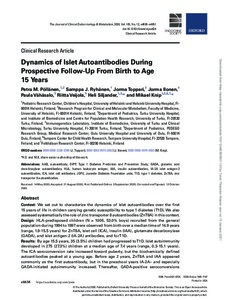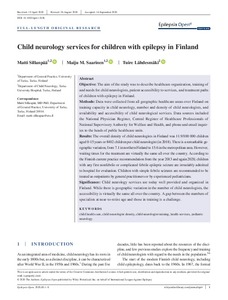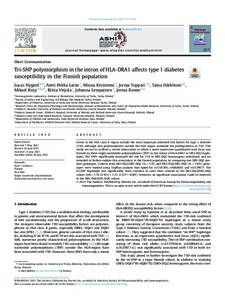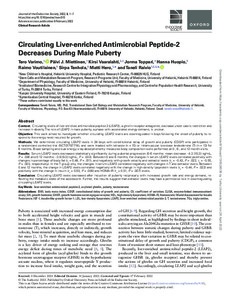Hae
Aineistot 21-30 / 78
Dynamics of Islet Autoantibodies During Prospective Follow-Up From Birth to Age 15 Years
Context: We set out to characterize the dynamics of islet autoantibodies over the first 15 years of life in children carrying genetic susceptibility to type 1 diabetes (T1D). We also assessed systematically the role of ...
Umbilical cord blood DNA methylation in children who later develop type 1 diabetes
<p><strong>Aims/hypothesis:</strong> Distinct DNA methylation patterns have recently been observed to precede type 1 diabetes in whole blood collected from young children. Our aim was to determine whether perinatal DNA ...
Child neurology services for children with epilepsy in Finland
<p>Objective<br />The aim of the study was to describe healthcare organization, training of and needs for child neurologists, patient accessibility to services, and treatment paths of children with epilepsy in Finland.<br ...
Neonatal Amygdala Volumes and the Development of Self-Regulation from Early Infancy to Toddlerhood
<p><i>Objective:</i> At the broadest level, self-regulation refers to a
range of separate, but inter-related, processes (e.g., working memory,
inhibition, emotion regulation) central for the regulation of cognition,
emotion ...
Maternal prenatal psychological distress associates with offspring early-life wheezing - FinnBrain Birth Cohort
<p><strong>Background: </strong>Exposure to prenatal maternal psychological distress may contribute to the development of childhood atopic disorders. Little is known about the importance of distress severity and its duration ...
An Infancy-Onset 20-Year Dietary Counselling Intervention and Gut Microbiota Composition in Adulthood
The randomized controlled Special Turku Coronary Risk Factor Intervention Project (STRIP) has completed a 20-year infancy-onset dietary counselling intervention to reduce exposure to atherosclerotic cardiovascular disease ...
Tri-SNP polymorphism in the intron of HLA-DRA1 affects type 1 diabetes susceptibility in the Finnish population
<p>Genes in the HLA class II region include the most important inherited risk factors for type 1 diabetes (T1D) although also polymorphisms outside the HLA region modulate the predisposition to T1D. This study set out to ...
Circulating Liver-enriched Antimicrobial Peptide-2 Decreases During Male Puberty
<p><strong>Context: </strong>Circulating levels of liver-enriched antimicrobial peptide 2 (LEAP2), a ghrelin receptor antagonist, decrease under caloric restriction and increase in obesity. The role of LEAP2 in male puberty, a phase with accelerated energy demand, is unclear.</p><p><strong>Objective: </strong>This work aimed to investigate whether circulating LEAP2 levels are downregulated in boys following the onset of puberty to respond to the energy need required for growth.</p><p><strong>Methods: </strong>We determined circulating LEAP2 levels in 28 boys with constitutional delay of growth and puberty (CDGP) who participated in a randomized controlled trial (<a href="http://clinicaltrials.gov/show/NCT01797718" title="See in ClinicalTrials.gov">NCT01797718</a>), and were treated with letrozole (n = 15) or intramuscular low-dose testosterone (T) (n = 13) for 6 months. Blood sampling and dual-energy x-ray absorptiometry-measured body composition were performed at 0-, 6-, and 12-month visits.</p><p><strong>Results: </strong>Serum LEAP2 levels decreased statistically significantly during pubertal progression (0-6 months: mean decrease -4.3 [10.3] ng/mL, P = .036 and 0-12 months: -3.9 [9.3] ng/mL, P = .033). Between 0 and 6 months, the changes in serum LEAP2 levels correlated positively with changes in percentage of body fat (r <sub>s</sub> = 0.48, P = .011), and negatively with growth velocity and estradiol levels (r <sub>s</sub> = -0.43, P = .022, r <sub>s</sub> = -0.55, P = .003, respectively). In the T group only, the changes in serum LEAP2 correlated negatively with changes in T and estradiol levels. Between 0 and 12 months, the change in LEAP2 levels correlated negatively with the change in high-density lipoprotein levels (r <sub>s</sub> = -0.44, P = .022) and positively with the change in insulin (r <sub>s</sub> = 0.50, P = .009) and HOMA-IR (r<sub>s</sub> = 0.51, P = .007) levels.</p><p><strong>Conclusion: </strong>Circulating LEAP2 levels decreased after induction of puberty reciprocally with increased growth rate and energy demand, reflecting the metabolic state of the adolescent. Further, the results suggest that estradiol levels may have a permissive role in downregulating circulating LEAP2 levels.</p>...
Neighborhood disadvantage, greenness and population density as predictors of breastfeeding practices: a population cohort study from Finland
<p><br></p><p>Background</p><p>Many environmental factors are known to hinder breastfeeding, yet the role of the family living environment in this regard is still poorly understood.</p><p>Objectives</p><p>Therefore, we ...









